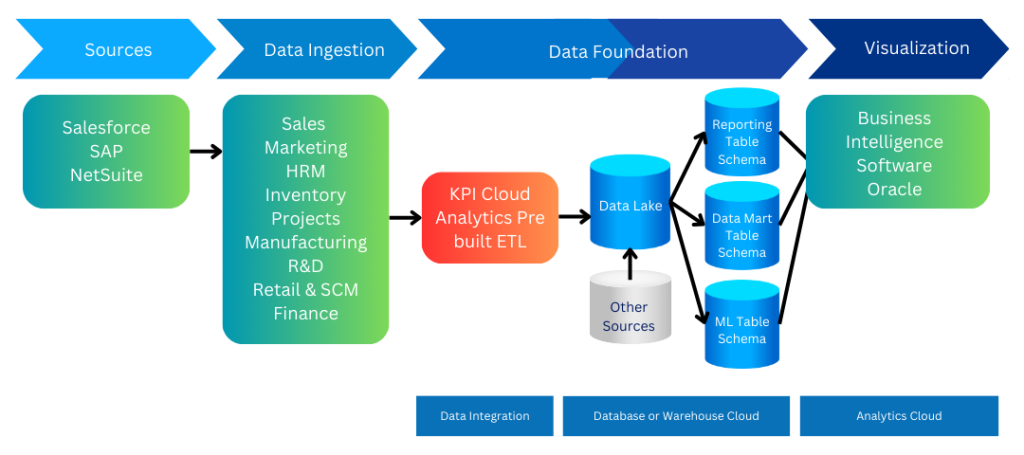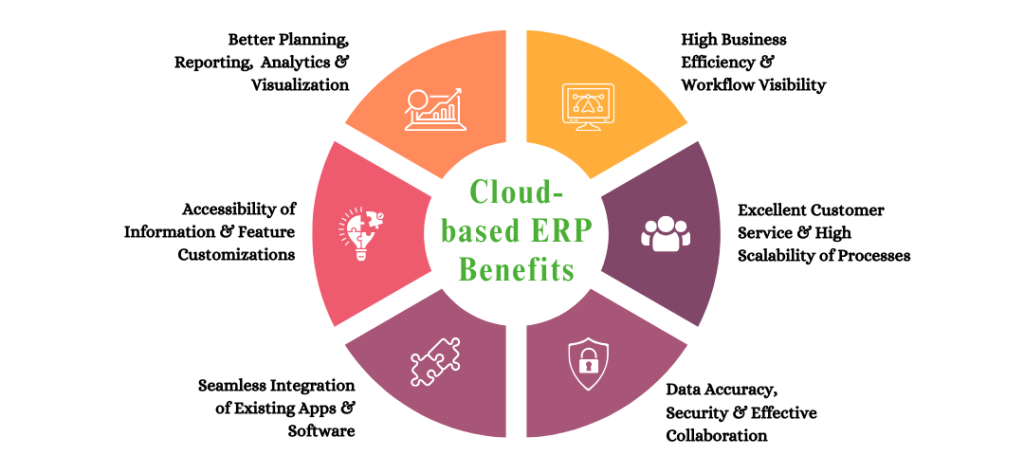Understanding Cloud-based ERP Systems
Enterprise Resource Planning (ERP) software is used by organizations to manage their businesses and related aspects on a unified platform. They can be useful for automating departmental processes such as HR, finance, manufacturing, supply chain etc. by handling accurate informational flow between them. Cloud-based ERP solutions are hosted on remote servers which are usually managed by third-party providers and can be easily accessed by businesses irrespective of geographical locations and time zones. These systems do not require on premise hardware like traditional ERP and are scalable, flexible and cost-effective solutions where businesses only need to pay for third-party services used.
With real-time updates, enhanced security measures, and seamless integration capabilities, cloud-based ERP systems streamline operations and improve overall efficiency within an organization. They can also integrate with other cloud-based modules without any additional downtime or hardware, enabling agility and proactiveness towards customer requests, changing market scenarios, consumer trends and other circumstances. The global market revenue for cloud ERP systems is projected to reach U.S $40.5 billion by 2025 increasing at a CAGR of 13.6% during the period 2019 to 2025.

Projected global market value of cloud-based ERP solutions from 2016 to 2028
History of Cloud-based Enterprise Solutions
1960s – 1970s: These were the precursor years of enterprise planning solutions where businesses used mainframes and minicomputers to manage their operations. It mainly consisted of Material Requirements Planning (MRP) systems that scheduled production and managed inventory.
1980s: These MRP systems further evolved into on premise Manufacturing Resource Planning (MRP II) systems which were integrated with additional features like manufacturing, finance and human resources functions.
1990s: Cloud computing had come into the picture and concept was driven by advancements in internet and increase in costs and demand for IT resources. Gartner coins the term ERP to encompass broader functions. In 1998, NetSuite started providing comprehensive ERP solutions via cloud.
2000s: Increase in viability of delivering software over internet, Software as a Service (SaaS), mobile cloud and boost to cloud-based apps and other web app development services with emergence of companies like Salesforce.
2010s: ERP vendors like SAP and Oracle started offering various cost-effective, scalable and flexible plans for cloud-based ERP systems with easier real-time software or customer purchase updates such as through retail self-checkout systems, automated bills at smart parking management system etc. than on premise systems. This was followed by the emergence of companies like Workday and Infor that accelerated digital transformation with cloud-native ERP solutions.
2020s: Acceptance of cloud ERP as mainstream solution for agile businesses, ease of remote work and adoption of AI, IoT and machine learning during the pandemic.
How Do Cloud-based ERP Solutions Work?
Cloud ERP can be accessed by users over the internet through mobile devices, desktop etc. and is constantly updated by the service provider for better security. It does not require company-owned servers and exhibits a low ownership cost. In most of the cases, they feature inter-departmental functions and multiple business operations for improved efficiency, customer experience, profits, enhanced scalability and accessibility, even from remote areas.
Modules
One of the most important cloud-based ERP advantages is that it can feature multiple components besides financial and accounting, such as human resources management tools, software for customer relationship management, inventory and order management, supply chain, warehouse management in logistics, procurement management, project and delivery management, material requirement planning and more.
Deployment
Cloud-based enterprise solutions can be deployed on premise on the organization’s privately hosted servers and computers managed by internal team or purchased as Software as a Service, where ERP software is hosted offsite on the vendor’s server and can be accessed through a browser. Major considerations include time for planning, cloud migration solutions, module customization and resource training. In the case of on premise deployment, the infrastructure and database are stored, managed and maintained in-house whereas in the latter case, the hosting provider manages associated components like enterprise-grade servers, underlying operating systems, networking, data and backup storage, antivirus, security software, physical data centers infrastructure, etc. and offers cloud benefits. Cloud-hosted ERPs are usually chosen when businesses are looking to scale or outsource their IT-related operations with end-to-end security via an encrypted connection between the vendor and client. In both cases, the organization is required to pay a fixed annual or monthly subscription amount for application maintenance services, troubleshooting, supplementary software, upgrade and new feature customizations.
Types
Cloud-based ERP solutions render a pool of resources that provide custom application development services for supporting the organization’s apps running on cloud and do not require dedicated infrastructure for each component of ERP software, and such a data center model allows simplified upgrades and aids the team to focus on the right metrics and workflow to attain business goals. In case of Public Cloud, which is owned by the cloud ERP vendor, many organizations are able to share cloud computing services offered without any access to each other’s data and apps, for example, Amazon Web Services (AWS), Microsoft Azure, Oracle Cloud with pay as you go services etc., though, in case of Private Cloud, the services are not shared amongst different clients. A Hybrid one showcases benefits of cloud ERP by combining any of the deployment models with private or public cloud for better storage and computing. Cloud ERP may also be offered as Multi-tenant Software-as-a-Service, in which a single instance of the software hosted on the same server and supporting infrastructure aids multiple clients with data isolation at shared costs. On the other hand, Single-tenant SaaS allows each organization to use a unique ERP software version and infrastructure, hosted on private servers and some vendors offer the option of either a private or shared instance.

High-level Architecture of cloud-based enterprise solutions
Benefits of Cloud ERP Systems
- Improved Efficiency: ERP systems deployed on cloud can automate routine tasks and business processes. One can also observe increasing integration of AI and Machine Learning with these systems for predictive analytics, automation and decision support. Customizable ERP systems can be reimplemented on future versions of the current software with in-house integrations.
- Enhanced Collaboration: The systems provide centralized databases that can be accessed across the globe on any device by the organization’s different departments. The total implementation and downtime are low as there is no requirement for selecting and setting hardware or hiring and training new IT staff.
- Real-time Updates: Any changes in the information stored in cloud-based enterprise solutions or directly obtained from receipt scanner API for automatic invoice recognition are updated on server in real-time. In addition to this, maintenance updates with the latest features and security patches are managed by the service provider or vendor on an ongoing basis. This allows faster and better decision making with secure access to up-to-date information and use of the latest technology as compared to traditional ERP system that require regular physical maintenance, upgrade and process management through hired contractors.
- Scalability: These systems can be tailored to easily adapt to growing business needs such as to build ecommerce mobile app, without any significant changes in infrastructure and hardware. It aids in overcoming challenges such as lack of local servers, addition of users, locations, branches, introduction of mergers, acquisitions, subsidiaries, split-ups, spin-offs etc. as new server units can be purchased via cloud vendors since they own reliable data centers across the globe.
- Cost-Effective: Amongst various cloud-based ERP advantages, flexible rate is the most attractive one. Custom-built or ready-made ERP systems are attributed to lower upfront or server purchasing costs, low implementation, infrastructure and database creation costs, reduced IT overhead, consultation and staffing costs as well as low security, maintenance and backup costs, compared to traditional on premise systems.
- Seamless Integration: Other cloud services and emerging technologies can be easily integrated with cloud-deployed ERP systems. For example, AWS in collaboration with SAP has integrated Generative AI into these systems which can streamline business processes. Another one of cloud-based ERP advantages is integration with IoT for real-time monitoring, operation management and insights into business processes.

Benefits of Cloud ERP Systems
- Data Security: Robust data security measures for protecting sensitive business information over cloud are one of the key features of these ERP systems. As relying on external servers for safeguarding organization’s data can be a concern for many, these systems adhere to industry-compliance and security regulations. Confidential data remains backed up with encryption, identity and access management and disaster recovery measures are put in place to avoid data loss due to fire, software failure, malware attacks, natural disasters or any other catastrophic event.
- Upgraded Storage: Vendors’ expandable data centers house organizational data and can be utilized as per business continuity plan that might involve new jobs and geographically variant operations. This process will not require considerable money or time and does not require data transfer to a new storage base as in the case of on premise systems.
Ease Cloud ERP Migration with KritiKal
We realize digitally transforming on premise legacy systems to cloud-based ERP systems can be a cumbersome task in terms of time, expertise and costs involved. In addition to that, even if businesses with many administrative and IT infrastructure teams wish to implement such drastic changes, they might experience push back from key stakeholders due to loss of control over processes that may be automated in the near future. Also, there are misconceptions around loss of data privacy and control over operational processes as vendors conduct manage and maintain infrastructure from the point of execution of transformation.
KritiKal’s proficient engineering teams can take business operations to the next level by migrating to cloud ERP and developing related solutions to provide real-time insights, better customer engagement, reduced logistics costs and automated financial functions, which can also be accessible through Android application development. This will help them address their target customers’ pain points, offer them requisite solutions and retain them in the long run, given the growing demand of cloud services. KritiKal has made strides as a SaaS provider accommodating regulatory compliances, security policies and hosting restrictions so that businesses can experience data sovereignty and reap the benefits of cloud ERP fully. Please mail us at sales@kritikalsolutions.com to know more about our services and avail benefits of cloud ERP.

Kashif Jamshed currently works as a Senior Software Engineer at KritiKal Solutions. He is proficiently skilled in handling various platforms and working with different types of software and programming languages such as React JS, Dot Net Core 6, MySQL, Redux, Full-Stack web development and more. He has consistently delivered high-quality code that surpasses project requirements and helped KritiKal in catering to some major clients.



 Global
Global  United States
United States 
